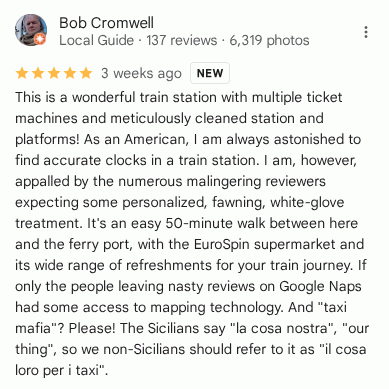
Vulcano
Arrival on Vulcano
Vulcano is the southernmost of
the Aeolian islands
in the Tyrrhenian Sea
north of Sicily.
It's about twenty kilometers from the coast of Sicily.
Vulcano is one of Italy's four active volcanos,
along with
Vesuvius,
Etna,
and nearby
Stromboli.
All are stratovolcanos,
the more explosive type.
Vulcano itself is the origin of the concept of a specifically
"vulcanian" explosive eruption.
The Greeks called the island both
Thirasía
and
Thérmessa,
Θηρασία
and
Θέρμεσσα,
and believed it to be the chimney of the forges
of Hephaestus or
Ἥφαιστος,
the ur-blacksmith and god of fire.
The Greeks didn't settle on the island because of the
poisonous fumes.
They did transport their dead by boat from the other Aeolian
islands to Vulcano to be purified by Hephaestus in sacred rites.
The Romans renamed Hephaestus for Spock's home planet, Vulcan,
called this island Vulcano,
and established a small settlement on it
to mine the sulfur and alunite.
Through Latin, the Roman name for the island
became the source of several related words in
European languages — volcano,
volcanic,
vulcanology,
and so on.
The last major eruption on Vulcano was in 1888–1890.
Fumaroles across the island continue to emit
water vapor along with hazardous gases —
hydrogen sulfide, sulfur dioxide, and carbon dioxide.

Part of aeronautical chart TPC G-2B from the Perry-Castañeda Library Map Collection at the University of Texas at Austin.
Getting to the Island
I traveled to Vulcano by taking a train to Milazzo and then a ferry to the island. This was early within my first-ever visit to Sicily, and I hadn't researched transportation details by the time I was wanting to set up my lodging. So, I took a train from Palermo to Milazzo about mid-day, and then walked to where I would stay overnight.
Guesthouses at Booking.comMilazzo is at the base of a narrow peninsula, so the rail line doesn't pass through its center. The Milazzo station is on the edge of town, and it was an easy, perfectly level, 1.4 kilometer walk to where I stayed at B&B Caravello, 54 Via dei Giardini, about half-way to the ferry terminal with a nice supermarket nearby.
The next morning I had an equally easy 2.4-km stroll from my lodging to the ferry terminal. I made the ferry connection between Milazzo and the islands on Sundays in both connections, the one day of the week there isn't a bus every 30 minutes between the port and the train station. No problem, it's easy to walk! On my return I walked all the way from the ferry terminal out to the train station, where I bought a ticket to continue to Messina.
But meanwhile on Google Maps... The reviews of the Milazzo station are filled with angry complaints — no multi-lingual station staff to sell tickets, no bars and restaurants in the station, the station isn't in the center of town, and on and on. One person claimed that it was the worst train station he had ever seen, suggesting that it must be about the only train station he has seen. The most ridiculous whining was from the people who were angrily entering their screeds into Google Maps while complaining that there was no way to know how to get from the station to the center.
I could not let that nonsense stand unmocked.

About the clocks: Chicago's Union Station has clocks within the station and out on the platforms showing the time and date.
The clocks will be up to eight hours behind or ahead, while the calendar will be up to nine months behind.
Knowing now what I learned about the frequency of trains between Palermo and Milazzo, and the ferry schedule in and out of Milazzo, I wouldn't stay overnight in Milazzo the next time. Trains between Palermo Centrale and Milazzo run about every hour through the week (although less often on Sundays), taking 2.5–3 hours. It's a 50-minute walk between the train station and the ferry terminal, and there's a ferry about every hour from 06:30 to 20:00.
Buy your ferry ticket out of Milazzo
on-line in advance.
You can buy a ticket in person at the terminal,
as I did,
but the transaction took a surprisingly long time.
Liberty Lines
So, a mid-morning train departure out of Palermo could put you on Vulcano by mid-afternoon.
Libery Lines operates ferries between Milazzo and the Aeolian islands. These are not cargo ships built at a phenomenal rate, but 400–500 ton high-speed passenger ferries.
SWATH or small-waterline twin-hull is a catamaran design that minimizes the cross-section area of the hull at the waterline. Buoyancy is provided by two cylindrical hulls that remain fully submerged. Only a minimal volume of the vessel is near the surface where wave energy is concentrated. The provides a much smoother ride.


Once on board you probably won't have a clear view due to salt haze and constant UV exposure on the window material.

We moved right along, at 45 km/h or 24.3 knots. Notice that GPS indicates being 38.2 meters above sea level, despite only being about three meters above the water. GPS is inaccurate for elevation. The visible satellites are spread around the sky, producing accurate X and Y coordinates, but they're all above you so Z or elevation is a much less accurate estimate. Plus, there are issues with the reference geoid and so on.

The Gabriele M soon arrived at the ferry pier on Vulcano!

Within a few minutes all disembarking passengers were off, several new passengers had boarded for the hop to the next island, and the ferry was on its way.

There was a handy map of the island in the shelter at the ferry pier. Most of the population lives in the town around the main ferry terminal, Porto di Levante. The population of the island was 953 at the 2011 census, but it had dropped to 450 by 2019.

The shelter also had a poster for the 1950 movie Vulcano, filmed here at the same time that Roberto Rossellini was making Stromboli on that nearby island. It was a year of Italian neorealism about volcanos and anguished women.

To my Lodging
Guesthouses at Booking.comI had a room reserved at Hotel Togo. It was an easy walk from the ferry pier — straight inland through town, almost but not quite a kilometer from the pier.

Each room has a nice veranda in front of it.

I could see the active volcano by stepping just outside my veranda.

Entering my room...




There was a nice desk and a mini-fridge next to the bathroom door, everything I needed! I visited Vulcano early in my 3.5-week trip around Sicily. I really enjoyed all of Sicily. However, Vulcano is my first choice for where to return for an extended stay just for relaxation, or maybe while working on a project.

Exploring the Port Town
The town has a couple of grocery stores and plenty of places to get a meal or just gelato.

Some people in Sicily eat ice cream in the morning and I am 100% on board with that.



Walking inland from the ferry pier, you go over a low rise and then pass a sulfurous hot spring with a strong odor.

Hydrogen sulfide or H2S is a colorless, toxic, corrosive, and flammable gas with an odor of rotten eggs.
Sulfur dioxide or SO2 is a colorless gas with the odor of burnt matches. It's toxic, but much less toxic than H2S.
Those two dangerous gases along with carbon dioxide or CO2, which becomes dangerous at higher concentrations, are present in the numerous fumeroles and hot springs on the island.
There are also scalding hot springs in the sea, close to the shore.
All of this makes for multiple simultaneous hazards. The entire area around the hot sulfur mud pond was fenced off. It had been a major attraction on the island, but during my visit you had to stay well back.

The Greeks who were settling the coasts of Sicily and southern Italy stayed away from Vulcano because of the dangerous gases. But the Romans established a settlement where they mined sulfur and alunite, KAl3(SO4)2(OH)6. Alunite is a form of alum which can be used as a mordant, a chemical that causes dye to "bite" into textiles. It was also used in medicine during Greek and Roman times, and styptic pencils live on as a medically-adjacent form of alum.

Solar-powered RF-linked gas sensors are distributed around the island. One is beside the hot sulfur mud pond.


Signs warn of the dangerous gases.
I grew up near French Lick and West Baden, Indiana, where amazing resorts were built for the well-off to "take the waters" from the late 1800s until the economic crash of 1929. Much of the spring and well water in the area is saturated with hydrogen sulfide, produced by subterranean bacteria rather than volcanic activity. The water has a strong laxative effect, valued back in those "good old days" when the American diet led to far worse constipation. Laxative-themed vacations, medicine was weird back then. The local H2-saturated water was bottled as Pluto Water, sold under the slogan "When nature won't, Pluto will." I grew up there, and then spent a lot of time back there in 2018–2021, and so I had a tolerance for H2 in the water and was unworried about drinking the local tap water in case of any emergency shortage of the local wine.
One state north in Michigan in the 1890s, George Kellogg had concluded that all problems came from constipation and masturbation, from which we got the US cereal industry for its laxative and, as per Kellogg, anti-masturbatory effects. Kellogg went on to support racial segregation and eugenics, The Road to Wellville took a light-hearted look at his lunacy.



Early Evening
Close to sunset on my first day on Vulcano, I walked back to the port. The active volcano looms over the town. The crater's rim is at about 270 meters elevation on its side toward town. A peak on the far side of the rim is at 391 meters. The next day, as shown on the following page, I would walk up to the crater rim and then around and beyond that to the peak.

The port was quiet after the last ferry had left.


The tsunami sirens remained silent.

Larger Ferries
Most of the ferry visits on Vulcano are the passenger-only high-speed ferries connecting Milazzo on Sicily to Vulcano and the other Aeolian islands. But a few larger ro-ro or Roll-On Roll-Off ferries carrying cars visit Vulcano. One arrived on a cloudy morning.

Each week, two or three overnight ro-ro ferries run between Milazzo and Napoli with stops in Vulcano and other Aeolian islands, leaving late afternoon into early evening and arriving the next morning.
Track LauranaThis one is Siremar's M/V Laurana — 123×19.40 meters, 11,200 gross tonnes, carrying up to 800 passengers and 272 cars.

Shops and restaurants restock by ferry.
A few lightweight cars provide connections between the port and outlying guesthouses.


The next page shows my ascent of the volcano, to its peak 386 meters above the port.
Where Next In Italy?
( 🚧 = under construction )
In the late 1990s into the early 2000s I worked on a project to
scan cuneiform tablets
to archive and share 3-D data sets,
providing enhanced visualization to assist reading them.
Localized histogram equalization
to emphasize small-scale 3-D shapes in range maps, and so on.
I worked on the project with Gordon Young,
who was Purdue University's only professor
of archaeology.
Gordon was really smart,
he could read both Sumerian and Akkadian,
and at least some of other ancient languages
written in the cuneiform script.
He told me to go to Italy,
"The further south, the better."
Gordon was right.
Yes, you will very likely arrive in Rome,
but Italy has domestic flights and a fantastic train system
that runs overnight sleepers all the way to
Palermo and Siracusa, near the western and southern corners
of Sicily.
So, these pages are grouped into a south-first order,
as they should be.

